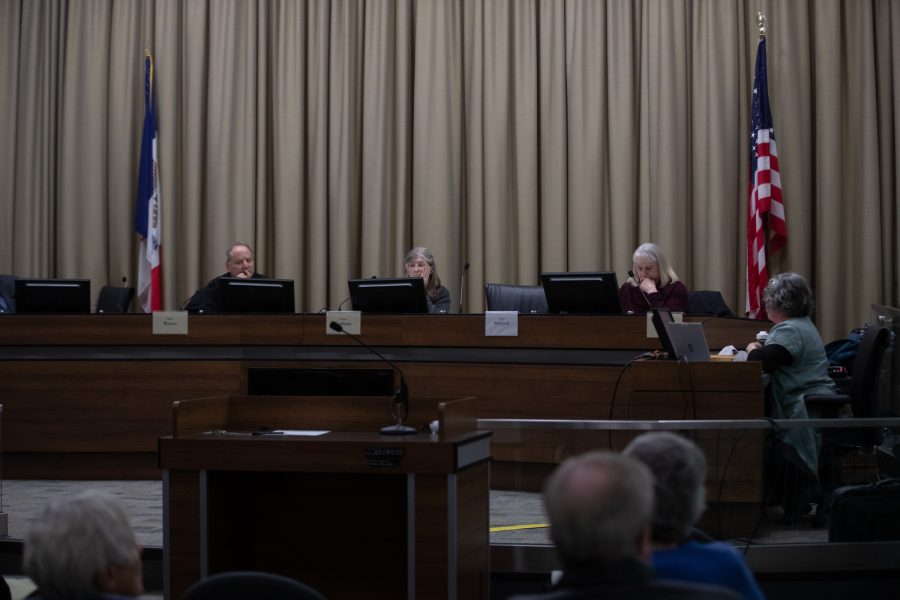UI Chi Omega chapter denied renovations to sorority house
The Iowa City Board of Adjustment denied the sorority’s request to replace its windows during its weekly meeting Wednesday night.
The Board of Adjustment listens during the Chi Omega Sorority House hearing at City Hall on Wednesday, March 8, 2023.
March 9, 2023
The University of Iowa’s Chi Omega sorority will not be installing new windows on the main level of its home.
The Iowa City Board of Adjustment unanimously voted to uphold the Historic Preservation Commission’s decision to deny the sorority’s request for window replacements on Wednesday night.
The commission previously failed to approve a Certificate of Appropriateness for the project at 805 Iowa Ave. on Jan. 12, citing that the proposed changes did not align with the guidelines for protected properties in the College Hill Conservation District.
Commission staff found the windows to “be in good condition” and noted that the proposal “would remove and replace historic wood windows that are not deteriorated,” which violates section 4.13 of the Iowa City Historic Preservation Handbook.
The handbook’s guidelines state that the commission recommends the repair of historic windows before replacement is considered and requires that replaced windows have similar characteristics and appearances to the original windows.
RELATED: Iowa City Historic Preservation Commission shuts down Chi Omega house changes, sorority
“The goal of the historical preservation and design review is to retain the historical character of the neighborhoods,” Jessica Bristow, Iowa City’s historic preservation planner, said. “We do that by retaining the historical character of the individual properties, and we do that by retaining the original material.”
Bristow added that the commission works with applicants to derive solutions.
“Our applications are not just a you submit the application and then we approve or deny whatever you have,” Bristow said. “We work with the applicant to come up with something that is approvable.”
James Phelps, a senior architect from Streamline Architecture who worked with Chi Omega on the project, asked the board to consider the previous renovations to the windows completed in 2016 to the backside of the house in collaboration with Streamline architects.
“We think it’s a reasonable request here considering that over 20 windows in this area have already been replaced,” Phelps said.
Phelps said following the denied request, Chi Omega received a list of recommended window experts. But out of the three he called, only two responded. He said the two experts that returned his calls described either not wanting to do the work or preferring to remove the windows before restoring them.
Additionally, Phelps said the contractors differed in their estimates of the proposed repairs, with a range between $1,000 to $4,000 per window. He said the cost of high-quality Pella windows would be a “fifth that and more”.
While Phelps admitted cost was a concern, he noted that the largest reason for the new windows was for the ease of maintenance new windows would provide.
“One of the huge considerations was the maintenance of it, just clearing a newer window with a title sash. They want to lower the sash down, tilt it in, and wipe it clean, and put it back. Very, very easy,” Phelps said. “I believe the lower windows now have the combination storms. I have the combination storms on my own 1924 house – [it’s] an absolute nightmare to clean.”
Nevertheless, board members quickly pointed out that the Historic Preservation Commission was acting within its regulations.
“Our purview here is extremely limited. You have to show us that the board acted arbitrarily and capriciously, or that they just ignore the law,” Board of Adjustments Vice President Mark Russo said. “The law is pretty clear on this.”
Board of Adjustment member Paula Swygard agreed with Russo.
“I think the process has been followed [and] the process is clear to the applicant,” Swygard said. “The overlay was started in 2003 and the precedent that they keep referring to was prior to that.”
Russo said the Board of Adjustment’s role was to make sure the commission abided by its regulations, which it did.
“Our role isn’t to second guess the historic preservation, but only to say that they follow the guidelines as they exist today,” Russo said. “I haven’t seen any evidence that suggests that the commission of historic preservation has skirted their review process.”














